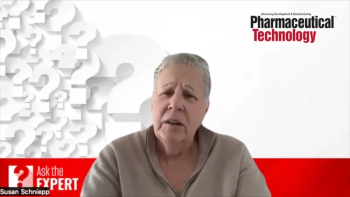
PTSM: Pharmaceutical Technology Sourcing and Management
- PTSM: Pharmaceutical Technology Sourcing and Management-01-31-2007
- Volume 3
- Issue 1
3M Drug Delivery Systems Advances Inhalation and Transdermal Drug Delivery
Following the sales of its global branded pharmaceutical business, 3M stays the course in drug delivery as its Drug Delivery Systems Division advances technology in inhalation and transdermal drug delivery.
When 3M Company (St. Paul, MN,
Advances in inhalation drug delivery
Inhalation drug delivery is well established, and recent advances by 3M focus on design improvements in pressurized metered dose inhalers (pMDIs) and extending the use of pMDIs to administering macromolecules such as proteins and peptides.
To further enhance product robustness, 3M continues to make improvements in the pMDI container-closure system (CCS).One improvement reduces the potentially problematic deposition of the active drug within the CCS by introducing can coatings (1). The company also is developing new fast-fill, fast-empty valve designs to improve dose-to-dose uniformity as well as to avoid the need for patients to prime the system if only used intermittently (2,3). In addition, 3M recently reported using a novel semipermeable system component to improve the dosing reproducibility of suspension formulations (4).
Ease of use is another important consideration in pMDI technology. Breath-actuation technology is one example. An established product in this area is 3M's "Autohaler," which removes the need for press-and-breathe coordination. More recently, 3M has developed a dose-by-dose counter for inclusion within the pMDI delivery system (5, 6) to meet new guidelines by the US Food and Drug Administration (Rockville, MD,
Looking ahead, 3M points to several key trends designed to improve the versatility and flexibility of pMDI-based delivery systems. For future market applications, there will be an increasing need to configure a delivery system containing fewer drug doses while retaining the same performance features. This may be driven by the development of new active drugs with longer durations of action and less-frequent dosing, demand for sample packs, or the future prospect of intermittent systemic therapies or even single-dose vaccine delivery. To this end, 3M has developed and reported on a range of pMDI delivery technologies suitable for reduced- (8) or single-dose product configurations (9).
Using pMDIs to administer macromolecules is another area of active research and development. One example of inhaled delivery of peptide and protein drugs to treat local or systemic disease is "Exubera" (inhaled insulin), recently approved in the United States and European Union.
3M says pMDIs offer several advantages for peptide delivery. First, the hydrofluroalkane (HFA) environment within a pMDI is inert and essentially moisture-free, which provides good stability for macromolecule drugs. Secondly, advances in valve and actuator technology in the pMDI help ensure a consistent and efficient delivery, an important consideration, given the cost and potency of biotech drug substances.
Despite these advantages, there can be formulation challenges in using pMDIs in administering proteins and peptides. Given the low solubility of proteins with HFAs, a suspension–formulation approach is required, which in turn will rely on the effective size reduction of the parent drug into a respirable size, while retaining its tertiary structure and biological activity, explains 3M.
To address these challenges, 3M demonstrated the feasibility of a suspension–formulation approach using particle-engineering technology with a range of molecules that included recombinant human deoxyribonuclease, adenosine deaminase, and salmon calcitonin. The integrity and stability of these molecules for extended storage periods has been demonstrated (10, 11). Molecule stability and pharmaceutical performance in pMDI systems also has been shown: further data generated using salmon calcitonin showed consistent results for in vitro drug purity and respirable fraction on product stability (12), as well as encouraging pharmacokinetic data in a rat model (13).
Also, as part of a strategy to improve delivery of a wider range of molecules via the inhalation route, 3M introduced a range of novel HFA excipients, including oligolactic acids (OLAs). The OLAs show improved functionality such as increasing solubility (14), enhancing suspension stability (15), and providing in vivo sustained release (16) of active ingredients.
Transdermal drug delivery
3M Drug Delivery Systems Division's other key technology platform is transdermal drug delivery (TDD), and microneedle or microstructured transdermal systems for vaccines is an emerging area of interest here. Other advances include improvement in liners, films, and adhesives used as components within TDD systems.
Drug-in-adhesive (DIA) systems are the most prevalent of established TDD designs. DIA systems offer advantages in simplicity, reduced size and thickness, and improved comformability to the application site.
Modified versions of the DIA design, reservoir designs, and, more rarely, matrix patches are other examples of TDD system designs.
"For drugs with a narrower therapeutic window or for which there is need for more temporal control of the delivery profile, systems with a rate-moderating membrane such as the multilaminate DIA or reservoir design are the best option," explains Tim Peterson, US early pharmaceutics and technology manager, 3M Drug Delivery Systems Division. "The multilaminate DIA combines most of the patient friendliness of the simple DIA design with added control over the drug delivery profile," he says. Another transdermal drug delivery type, matrix patches, are seldom used because they require an additional peripheral adhesive to hold the system in place, which in turn increases the overall patch size and thickness.
3M recently developed new components for transdermal drug delivery. These include fluoropolymer-coated release liners for use with new soft adhesives and formulations, ultraviolet blocking films for light-sensitive formulations, and microlayered films that are designed to be soft and occlusive.
In terms of system design for drug delivery, Peterson says the company develops customizable adhesives to improve the adhesion and drug-delivery performance of DIA products. The incorporation of microstructured adhesives is another recent advance that has the potential to improve the performance of DIA patches in several areas, including minimizing skin occlusion and reducing skin irritation (17–19).
Microstructured transdermal system
Articles in this issue
almost 19 years ago
Mergers, acquisitions, and restructuringalmost 19 years ago
Agreements and contractsalmost 19 years ago
Expansionsalmost 19 years ago
Peoplealmost 19 years ago
Changing Fortunes in Pharmaceutical Manufacturingalmost 19 years ago
Simpler is BetterNewsletter
Get the essential updates shaping the future of pharma manufacturing and compliance—subscribe today to Pharmaceutical Technology and never miss a breakthrough.




